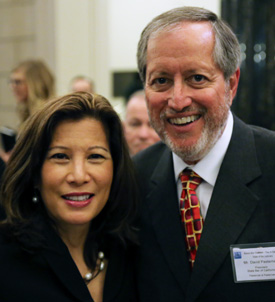Chief justice calls for webcast of oral arguments, bail
reform
By Amy Yarbrough
Staff Writer
In a move aimed at making the state’s court system more transparent,
the California Supreme Court will soon start webcasting its oral arguments.
 |
| Tani Cantil-Sakauye and State Bar President David Pasternak |
The announcement came during the annual State of the Judiciary
address to legislators on March 8, when Chief Justice Tani Cantil-Sakauye also highlighted
other court improvements and called for reforms, including to the bail system.
The webcasts will begin at the court’s May oral argument
sessions in San Francisco, according to Cathal Conneely, a spokesman for the Judicial
Council. Although the court’s special outreach sessions with high school and
law students have been broadcast online since 2005 and audio and video in other
select cases have been made available, webcasts have not been a regular
practice until now, Conneely said.
Now in her sixth year as chief justice, Cantil-Sakauye also
spoke of the need to eliminate inequities in court fees and fines, which she
said have “morphed from a system of accountability to a system that raises
revenue for essential government services.”
Of the approximately $1.7 billion the judicial branch brings
in each year, more than 60 percent pays for programs at the state and local
level. The rest goes back into the court system, she said.
Even so, progress is being made, according to Cantil-Sakauye.
She heralded a traffic amnesty bill the Legislature passed last year that has
restored licenses to thousands of Californians and a traffic rule approved by
the Judicial Council that allows people with moving violations to appear in
court without first having to pay bail.
“We still have much to do for fines, fees and assessments
but this is a start,” she said.
Cantil-Sakauye also said it’s time to consider whether bail
serves its purpose of ensuring public safety or if it unfairly penalizes the
poor. She noted that some studies show pretrial detention can increase
recidivism and that supervised release can be as effective as money bail.
Two years ago, the Judicial Council received money that led
to the creation of 12 court pretrial release programs. But Cantil-Sakauye said
the state needs even more.
“We must not penalize the poor for being poor,” she said.
The chief justice also called attention to the need to
adequately fund dependency counsel, noting there are more than 155,000 children
and families who need specially trained attorneys. Currently, the estimated
caseload for those attorneys is 225 clients per attorney.
“That can’t be fair to children, to families, to the
attorneys and the judges who oversee these matters,” she said.
As it tackles the challenges ahead, the judicial branch does
so having been made “leaner by the greatest recession in California’s history,”
Cantil-Sakauye said.
“We’ve endured, and we’ve changed for the better. We have
publicly met the heat of unprecedented budget cuts, and we have downsized in
all levels of the judiciary with these goals in mind: to serve the people and
to ensure justice and fairness,” she said.
Among other modernizing efforts, dozens of superior courts
are in the process of updating antiquated computer systems.
“Because of improved systems, we will see more efficiency,
better access and useable data upon which we can make smart choices going
forward for the public,” she said. “We’ve re-engineered, but we’ve also
adapted. We’ve also reformed, and we’ve never relinquished our commitment to
access, fairness and diversity.”